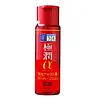What's inside
What's inside
 Key Ingredients
Key Ingredients

 Benefits
Benefits

 Concerns
Concerns

 Ingredients Side-by-side
Ingredients Side-by-side

Water
Skin ConditioningGlycerin
HumectantButylene Glycol
HumectantDimethicone
EmollientAlcohol
AntimicrobialCetyl Alcohol
EmollientGlyceryl Behenate
EmollientPetrolatum
EmollientCetyl-Pg Hydroxyethyl Palmitamide
Skin ConditioningStearoyl Glutamic Acid
CleansingSorbitan Distearate
EmollientArginine
MaskingMethylparaben
PreservativeBetaine
HumectantXylitol
HumectantPotassium Hydroxide
BufferingBHT
AntioxidantSodium Hyaluronate
HumectantSoluble Collagen
HumectantTocopherol
AntioxidantAlcohol Denat.
AntimicrobialCarbomer
Emulsion StabilisingWater, Glycerin, Butylene Glycol, Dimethicone, Alcohol, Cetyl Alcohol, Glyceryl Behenate, Petrolatum, Cetyl-Pg Hydroxyethyl Palmitamide, Stearoyl Glutamic Acid, Sorbitan Distearate, Arginine, Methylparaben, Betaine, Xylitol, Potassium Hydroxide, BHT, Sodium Hyaluronate, Soluble Collagen, Tocopherol, Alcohol Denat., Carbomer
Water
Skin ConditioningButylene Glycol
HumectantGlycerin
HumectantHyaluronic Acid/Polyglutamic Acid Crosspolymer
AntioxidantSodium Hyaluronate
HumectantHydrolyzed Hyaluronic Acid
HumectantHydrolyzed Elastin
EmollientTetrapeptide-5
Skin ConditioningHydrolyzed Collagen
EmollientLactobacillus
Skin ConditioningPhytosteryl Macadamiate
Skin ConditioningPhytosteryl/Octyldodecyl Lauroyl Glutamate
Skin ConditioningSqualane
EmollientDiglycerin
HumectantPullulan
Limnanthes Alba Seed Oil
Skin ConditioningPentylene Glycol
Skin ConditioningPolyquaternium-51
Skin ConditioningIsohexadecane
EmollientXanthan Gum
EmulsifyingCarbomer
Emulsion StabilisingCaprylic/Capric Triglyceride
MaskingPPG-10 Methyl Glucose Ether
Skin ConditioningPolyacrylate Crosspolymer-11
Emulsion StabilisingHydroxyethyl Acrylate/Methoxyethyl Acrylate Copolymer
Polysorbate 60
EmulsifyingAmmonium Acrylates Copolymer
PEG-20 Sorbitan Isostearate
EmulsifyingMelaleuca Alternifolia Leaf Oil
AntioxidantDisodium EDTA
Methylparaben
PreservativeWater, Butylene Glycol, Glycerin, Hyaluronic Acid/Polyglutamic Acid Crosspolymer, Sodium Hyaluronate, Hydrolyzed Hyaluronic Acid, Hydrolyzed Elastin, Tetrapeptide-5, Hydrolyzed Collagen, Lactobacillus, Phytosteryl Macadamiate, Phytosteryl/Octyldodecyl Lauroyl Glutamate, Squalane, Diglycerin, Pullulan, Limnanthes Alba Seed Oil, Pentylene Glycol, Polyquaternium-51, Isohexadecane, Xanthan Gum, Carbomer, Caprylic/Capric Triglyceride, PPG-10 Methyl Glucose Ether, Polyacrylate Crosspolymer-11, Hydroxyethyl Acrylate/Methoxyethyl Acrylate Copolymer, Polysorbate 60, Ammonium Acrylates Copolymer, PEG-20 Sorbitan Isostearate, Melaleuca Alternifolia Leaf Oil, Disodium EDTA, Methylparaben
Ingredients Explained
These ingredients are found in both products.
Ingredients higher up in an ingredient list are typically present in a larger amount.
Butylene Glycol (or BG) is used within cosmetic products for a few different reasons:
Overall, Butylene Glycol is a safe and well-rounded ingredient that works well with other ingredients.
Though this ingredient works well with most skin types, some people with sensitive skin may experience a reaction such as allergic rashes, closed comedones, or itchiness.
Learn more about Butylene GlycolCarbomer is a polymer of acrylic acid. Its main role is to create a gel consistency.
A high amount of carbomer can cause pilling or balling up of products. Don't worry, most products contain 1% or less of carbomer.
Glycerin is already naturally found in your skin. It helps moisturize and protect your skin.
A study from 2016 found glycerin to be more effective as a humectant than AHAs and hyaluronic acid.
As a humectant, it helps the skin stay hydrated by pulling moisture to your skin. The low molecular weight of glycerin allows it to pull moisture into the deeper layers of your skin.
Hydrated skin improves your skin barrier; Your skin barrier helps protect against irritants and bacteria.
Glycerin has also been found to have antimicrobial and antiviral properties. Due to these properties, glycerin is often used in wound and burn treatments.
In cosmetics, glycerin is usually derived from plants such as soybean or palm. However, it can also be sourced from animals, such as tallow or animal fat.
This ingredient is organic, colorless, odorless, and non-toxic.
Glycerin is the name for this ingredient in American English. British English uses Glycerol/Glycerine.
Learn more about GlycerinMethylparaben is a preservative and is a paraben. It is used to prevent the growth of fungus, mold, and other harmful bacteria. Parabens are chemicals used as preservatives in both cosmetics and food.
Methylparaben can be synthetically created. It can also be found naturally in some fruits, such as blueberries.
Oftentimes, Methylparaben is combined with other parabens to help increase the shelf life.
The safety of Methylparaben is currently being studied. While ongoing studies are looking into the safety of parabens, the results have been very mixed. Some studies have not found Methylparaben to be harmful.
Learn more about MethylparabenSodium Hyaluronate is hyaluronic acid's salt form. It is commonly derived from the sodium salt of hyaluronic acid.
Like hyaluronic acid, it is great at holding water and acts as a humectant. This makes it a great skin hydrating ingredient.
Sodium Hyaluronate is naturally occurring in our bodies and is mostly found in eye fluid and joints.
These are some other common types of Hyaluronic Acid:
Learn more about Sodium HyaluronateWater. It's the most common cosmetic ingredient of all. You'll usually see it at the top of ingredient lists, meaning that it makes up the largest part of the product.
So why is it so popular? Water most often acts as a solvent - this means that it helps dissolve other ingredients into the formulation.
You'll also recognize water as that liquid we all need to stay alive. If you see this, drink a glass of water. Stay hydrated!
Learn more about Water